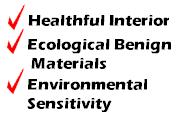
MARMOLEUM FLOORING
IN THE BATHROOMS AND STORAGE/UTILITY ROOMS
Marmoleum is a type of linoleum that has been used for almost a hundred years, the principal component still being linseed oil. This oil is produced from the seeds of flax plants. Linseed oil is oxidised according to old-established principles, through exposure to oxygen. During the oxidation process it is mixed with natural resins to obtain a flexible binding, together with wood and cork flour, limestone and pigments for various colours. The pigments used are completely harmless from an ecological point of view. The product is low maintenance and is extremely durable.

PAINT WITH LOW VOC'S
Paint finishes with low volatile organic compounds minimize off gassing in the home.

CUPBOARDS THAT MINIMIZE OFF-GASSING
The frames and countertops in kitchen cupboards are typically made with MDF (Medium Density Fibreboard). The glue in regular MDF emits formaldehyde gas which is released from unsealed areas (shelf edges and the underside of the countertop). Using special formaldehyde free MDF for the countertop practically eliminates the release of formaldehyde gas.
Performance targets for a "Green Project"
- To maximize the use of environmentally friendly and sustainable materials and products and minimize loss due to waste.
- To maximize ease of operation and minimize long term maintenance
- To ensure air quality by:
- minimizing sources of contaminants from materials
- provide fresh clean air at the rate of one air exchange per hour directly to each suite
- compartmentalizing (hermetically seal) suites from each other, the common spaces, and the outside
- To ensure electrical efficiency by:
- using state of the shelf energy efficient fixtures
- maximizing natural lighting in living areas
- using the occupancy sensors where appropriate
- To ensure heating efficiency by:
- use high efficiency heat units
- optimizing the insulation values in the walls and windows
- recapturing and reusing waste heat
- To ensure cooling efficiency by:
- minimizing cooling load by use of appropriate window glazing
- minimize free cooling
- controlling solar heat gain
- To ensure acoustical comfort by:
- minimizing sound transmission from suite to suite (both airborne and impact) such that normal use will not generate suite to suite sound contamination.
- minimizing mechanical sound (water, motors, etc.)
- To minimize water consumption by:
- using state of the shelf technology for toilets, showers, and taps, and appliances
- To rationally address garbage by:
- design which facilitates recycling
- minimizing construction waste